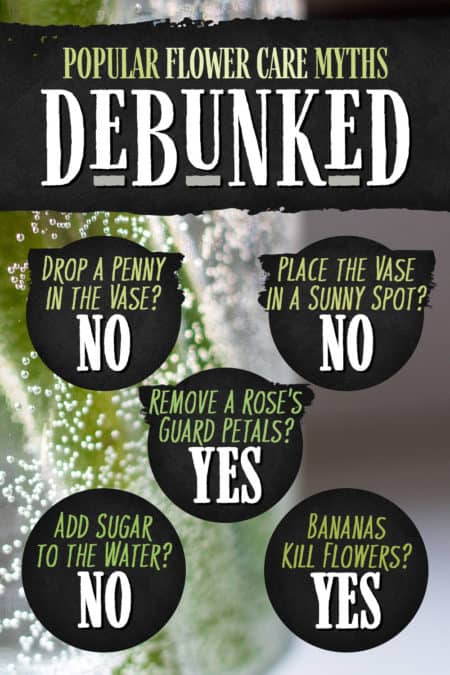Receiving a beautiful bouquet of flowers is one of the greatest gifts anyone can get, so, naturally, we want to do anything we can to make our fabulous blooms last as long as possible. Following flower care advice you heard while growing up, or information you found on the internet could do more harm than good to your fresh blooms. The flower experts here at Charlotte’s premier florist, The Blossom Shop , are setting the record straight for you. To keep your flowers fresh for as long as possible, we’re debunking some of the more common flower care myths we’ve come across. Keep reading to discover what you should and should’t do when it comes to caring for your precious blooms.
Common Flower Care Myths to Avoid
Myth #1Putting a Penny in the Bottom of the Vase Keeps Flowers from Wilting
This myth has been around a while and still touted by relatives and online plant enthusiasts. Adding a penny to your vase of flowers is an old myth that came about because copper is a natural fungicide, which could help blooms stay fresher, longer. However, copper stopped being used to make pennies in 1982. Today, they are composed of mostly zinc which will have no effect on your flowers. Besides, even if you do find a pre-1982 penny, you risk adding germs and bacteria into the water, negating any good the copper might do. It’s best to keep the coins for the piggy bank.
Myth #2Allergy Sufferers Can’t Enjoy Flowers
It is often assumed people who have allergies need to stay away from flowers or else they’ll become a sneezing, runny-nose mess. However, many flower varieties are fine for people with allergies to be around. These include blooms that have minimal amounts of pollen, heavy pollen that is not likely to become airborne, or have been insect-pollinated instead of pollinated by the wind. Pansies, carnations, orchids, hydrangea, and peonies are insect-pollinated and safe for allergy sufferers. Roses have minimal amounts of pollen that’s not likely to become airborne, so they are also safe. Flowers with high amounts of pollen allergy sufferers should stay away from include lilies and sunflowers.
Myth #3Sugar or Lemonade Can Be Used as Flower Flood for Your Cut Stems
Do not put sugar or lemonade in your flowers’ water. This will only make the water get gunky and green faster than usual. Sugar and lemonade will stimulate the growth of bacteria and will kill your flowers quicker. The same with aspirin – an old wive’s tale that does not affect your flowers whatsoever. Ignore the myths about adding vodka or bleach, also. Your safest bet when it comes to keeping your fresh blooms healthy for as long as possible is to change the water daily and use only the flower food packet from the florist.
Myth #4Lilies Will Die if You Remove the Anthers
Not true! The anthers should be removed from lilies as their pollen is highly toxic to dogs and cats. Not to mention this is sticky pollen that can stain carpets, walls, clothes, and nearly anything else it lands on. To remove the anthers, or the whole stamen, gently pull them out and then quickly place them in a nearby container. Wash your hands afterward to eliminate any residual pollen.
Myth #5Removing a Rose’s Guard Petals Will Make it Die Quicker
The outer petals of a rose, known as the “guard petals,” can often become brown and ripped around the edges. Gently removing them to reveal the pristine petals underneath is perfectly fine and won’t cause the bud any harm. The roses will look prettier when on display once they are removed.
Myth #6Fresh-Cut Flowers Prefer a Sunny Location
Placing your vase of beautiful flowers in a sunny window will actually shorten their lifespan. The sun makes the blooms open quicker, leading to an overall shortened lifecycle. To enjoy your cut flowers for as long as possible, keep them in a cool location away from direct sunlight.
Myth #7Seasons Don’t Matter – Flowers are Available All Year Round
Those who have their heart set on specific flowers for a special event and ignore the available seasonal blooms are making a costly mistake. It’s true we live in an age that allows us to import out-of-season flowers from greenhouse growers, but these are often much more expensive and require a lot more effort to produce, resulting in a bigger carbon footprint. Stick with seasonal blooms – they’re better all around.
Bonus MythBananas Kill Flowers
This one’s true! Ripening fruit such as bananas, oranges, and apples emit ethylene gas, which shortens a flower’s life. Keep your vase of fresh blooms a reasonable distance from your bowl of fruit, and they will be fine.
Forget all the old wives’ tales and internet myths about caring for flowers. The task is really quite simple. To keep your fresh-cut flowers healthy and vibrant for as long as possible, follow these simple steps:
- Remove any leaves and petals which fall below the waterline.
- Cut the stems at a 45-degree angle with each change of water.
- Change the water daily for the best results.
- Only use the packet of flower food from the florist.
- Keep flowers out of direct sunlight.
For more detailed information on how to care for flowers, visit our Flower Care Page.
Cut flowers that are cared for properly can last up to 10-12 days, so go ahead and brighten your home and your spirits with a beautiful arrangement of fresh blooms today.



